Features
Right now, there is arguably no greater technical challenge for the UK, and the rest of the world, than the energy systems transition. Radical challenges require radical solutions.
The way we source energy, the way we use it domestically, at work, the way transport is powered...and how this is all financed and implemented – are all pieces of an extremely complex puzzle
The way we source energy, the way we use it domestically, at work, the way transport is powered and how this is all financed and implemented – are all pieces of an extremely complex puzzle.
Recent international diplomatic crises, surges in UK energy prices and political lobbying have starkly highlighted this.
Each component of our energy system presents its own challenge, with its own stakeholders, and yet each needs to work seamlessly together in a unified system, if we are to meet our carbon reduction commitments.
Everyone needs to be able to adapt to the changes and they need to benefit those at all stages of life, financial situations and geographical locations.
Such complexity requires the minds of many, and for all considerations to be represented in the thinking. Technological innovation and changes in habit will only be embraced if they work on the ground and benefit lives already stretched with demands on time and money.
A new world-leading multi-disciplinary hub and co-working space in Oxford, Mini TESA - The Energy Systems Accelerator pilot - aims to...tackle the challenge. And this month, it opens its doors
A new world-leading multi-disciplinary hub and co-working space located in Oxford, Mini TESA - The Energy Systems Accelerator pilot – aims to bring such minds together to tackle the challenge. And this month, it opens its doors.
Located in a converted 1960s building on an industrial estate, that is home to an assorted mix of research labs, start-ups, social enterprises and wholesale food markets, a stone’s throw from the city’s rail station, the refitted interior is a vision for a new way of working and a catalyst for change.Inside this building three exciting things are happening simultaneously, which could just lead the way to creating a blueprint for the UK’s energy systems transition.
Firstly, in a unique working arrangement, scientists are sharing space with social enterprises, industrial and local government stakeholders. Concerns about intellectual property (IP) which have traditionally funnelled scientific groups into tightly protected groups, working in highly specialised siloes, have been re-thought so a shared mission enables collaborations previously thought impossible.
Secondly, scientists, researchers and university academics from a wide variety of disciplines are physically working together to pool expertise and think through problems from multiple perspectives – from the sharp end of technological challenges and the economics of how this works in financial systems, to the human behaviour considerations needed for adaptation.
Thirdly, teaching and research are flourishing side by side with the University of Oxford’s MSc in Energy Systems led by Professor Wallom, taught in open, adaptable learning spaces right across the hall from one of the country’s most prestigious energy research labs led by Malcolm McCulloch - Associate Professor in Engineering Science and head of the Energy and Power Group at the University of Oxford.
This is one of many innovative projects that aims to accelerate the UK’s economic revival while delivering sustainable growth across the country
Greg Hands MP, Minister for Energy, Clean Growth and Climate Change
Greg Hands MP, Minister for Energy, Clean Growth and Climate Change, said on its launch: ‘Today marks an exciting new chapter for Oxfordshire with this flagship project set to make waves across the UK energy sector and local economy.
‘As part of the Government’s ‘Getting Building Fund’, this is one of many innovative projects that aims to accelerate the UK’s economic revival while delivering sustainable growth across the country.’
Professor Chas Bountra, Pro-Vice Chancellor (Innovation) for the University of Oxford, said: ‘The University is proud to be leading this project, bringing together engineers, scientists and social scientists from within the University to work closely with businesses and civic stakeholders.
‘The Oxford innovation ecosystem is the perfect place for this collaboration to ensure we make the very best improvements to energy systems that will contribute to a zero-carbon future. Not only that, but TESA will support entrepreneurs building new businesses, create jobs, and encourage investment and economic growth in the local community and across the UK.’
The Oxford innovation ecosystem is the perfect place for this collaboration....Not only that, but TESA will support entrepreneurs building new businesses, create jobs, and encourage investment and economic growth
Professor Chas Bountra, Pro-Vice-Chancellor, Innovation
The radical approaches piloted here are part of a distinct and focused vision which has its sights on a new, permanent building, employing 800 people from a broad spectrum of professional backgrounds to make the energy systems transition happen in the most efficient, sustainable and equitable way possible.
Mini TESA has four years to prove its approach will lead to the outcomes the country and our planet need to safeguard the future. And while ‘serendipitous innovation’ is a watchword of what is hoped will happen within these walls, there is nothing accidental about its development.
With Oxford spearheading two of the country’s major demonstrator clean growth projects funded through Innovate UK’s Industrial Strategy Challenge Fund – Project Local Energy Oxfordshire (LEO) and Energy Superhub Oxford, the city is fast becoming a sustainable energy pioneer by making itself both the subject and instrument of research and planning. The aim is that by fusing the vision, the precision and the pragmatism, its solutions will be ready to scale up with speed when the policy lights turn green.
As part of World Cancer Day 2022 we are diving into 10 of Oxford’s most impactful historical and modern contributions to the field of cancer science and treatment. Read more about what Oxford researchers have done to shape this ever-important area of medical science.
1. Uncovering the significance of hypoxia in cancer science
A discovery so significant that it warranted a Nobel prize: Sir Peter Ratcliffe is famed for his work on oxygen deprivation (hypoxia) and subsequent cellular responses.
Cancers have unique microenvironments, which they must overcome in order to grow rapidly and uncontrollably. By understanding these conditions and how they come about, clinicians and researchers can strive to develop new drugs to reverse or suppress these pathways.
During his time in Oxford’s Nuffield Department of Medicine, Sir Peter discovered that a specific hormone, known as EPO, was involved in the production of blood cells in response to low oxygen levels in the kidneys. The underlying mechanism behind this process was later applied to cancer, and explained how cancers could create new blood vessels to sustain their fast and uncontrolled growth. This discovery was so significant, he was awarded the Nobel Prize in Medicine in 2019. Ratcliffe’s work into EPO has paved the way for the development of new drugs to improve the efficacy of cancer treatments.
NOW: Continuing this important work into tumour microenvironments, the Oxford ARCADIAN project is now investigating how common antimalarial drug Atovaquone can help to reduce the hypoxic environment of tumours and improve the efficacy of treatments such as radiation.
2. The discovery of regulatory T-cells (Tregs) told us a lot about how cancers can progress
Regulatory T cells, also known as Tregs, were first discovered in 1990 by Fiona Powrie and collaborators, whilst at the Sir William Dunn School of Pathology at the University of Oxford.
Regulatory T cells (Tregs) are a specialized subpopulation of immune cells that act to suppress the body’s immune response. Because of this, their importance in the cancer development process cannot be understated. If there is a dysregulation in Treg frequency or function, diseases such as cancer can be allowed to thrive and progress. The discovery of Tregs has explained - in part - why the immune system does not effectively defend against tumour cells, as well as identifying a new avenue for targeted cancer treatment. Since their discovery, a taxonomy of new Treg subtypes with varying functionalities have been found, further diversifying the potential for new therapeutic targets.
NOW: Developments into Immuno-oncology remains one of the four priority cancer themes at the University of Oxford, with researchers at the interface between cancer and immunological sciences striving to unravel the mysteries of the immune system. As part of this dedication, the University looks forward to welcoming the launch of the upcoming Oxford Centre for Immuno-oncology in 2022.
3. Shaping public policy around the risk of smoking, diet & cancer
There are many potential environmental factors linked to cancer, but smoking and diet are two factors that are known for certain to significantly increase your risk. However, it took a long time for society to understand this risk, and for smoking cessation and diet to be integrated into public health policy.
Sir Richard Peto dedicated his research in Oxford to unravelling the connections between smoking, diet and cancer risk. Through his meta-analyses we have found key pieces of information that have contributed significantly to shaping public policies, such as showing that UK cancer death rates are still one-third higher than they would be if people didn’t smoke. He was also the first to describe the future worldwide health effects of current smoking patterns, predicting one billion deaths from tobacco in the present century if current smoking patterns persist.
He and his colleagues are running studies of millions of people followed for many years in many countries to assess the changing effects of smoking, drinking, diabetes and obesity on death from cancer and many other conditions. As the world’s leading expert on death related to tobacco, Sir Richards’s work in cancer was so significant, he even had a paradox named after him.
NOW: His work has inspired many more in Oxford to investigate the causational links between lifestyle and cancer, through the ongoing work of the Cancer Epidemiology Unit, European Prospective Investigation into Cancer and Nutrition (EPIC) and with international datasets such as the China Kadoorie Biobank.
4. Developing simple cancer blood tests and rolling them out into the NHS
Diagnosing cancer can take time. From the moment a patient sees their GP they may undergo rigorous and invasive testing, which take time and resources. As we learn more about cancer, we are finding unique features that allow us to develop new, simple tests to accurately and quickly diagnose multiple cancers.
Liquid biopsies, such as blood or urine, can be used to find trace-materials indicative of cancer. This is leading to a revolution in early-cancer-detection blood tests being developed and trialled in Oxford. Some researchers are developing tests to identify genetic material of cancers, whilst others are looking for cancer metabolites, and all are showing very promising early results.
NOW: Oxford is currently involved in the SYMPLIFY study – validating the use of one such blood test within the NHS. Initial results from the nationwide study are expected to be released by 2023. If positive, the study will be expanded to involve around 1 million participants in 2024 and 2025 before potential roll-out into the NHS for general use.
5. The link between HRT and cancer risk, and informing its use
Hormone replacement therapy (HRT) came as a blessing to many menopausal women in the late 1990s. However its discovery was somewhat dampened as results of the Women’s Health Initiative in 2002, which showed that HRT had potentially more detrimental effects than beneficial ones. Its association with increased risk of cancer meant that public and medical opinion quickly changed: its usage was quickly unrecommended, leading to negative consequences for the health and quality of life of menopausal women.
The work of the late Dame Valerie Beral and the Million Women Study (MWS) was quick to delve further into these cancer-related links, in order to better understand HRT and inform its usage. The MWS, opening in 1997, recruited more than 1.3 million UK women over 50, becoming the biggest dataset of its kind at the time.
Results from the study in 2003 confirmed the associated risk of HRT with certain cancers, such as breast cancer. But more importantly, the study also showed that risk increases the longer a woman uses HRT, but drops to the normal level within five years after stopping use. This discovery was significant in defining recommended length usage of HRT, and allowed patients and clinicians to weigh up the associated risks of HRT against the benefit to a woman’s wellbeing.
NOW: Dame Valerie’s legacy into improving women’s health continues in Oxford with the work of ovarian cancer researcher Ahmed Ahmed and the continuation of the Cancer Epidemiology Unit where her work originally took place.
6. Developing new drugs to treat historically difficult-to-treat cancers
Cancer treatments are never a one-size-fits-all solution. There is always a need to discover new therapeutic drugs that target specific cancer subtypes, or can treat cancers that do not currently have any effective treatment options. Researchers at the University of Oxford from departments such as Chemistry, Biochemistry, Pharmacology and Oncology are continuing to develop new treatments for patients with little or no viable treatment options.
NOW: The immunotherapy drug Tebentafusp has been tested in Oxford clinical trials and shown to improve the longevity of patients with metastatic uveal melanoma – a cancer that is historically hard to treat. Now in its Phase 3 of clinical trials it has become the first new therapy to improve the overall survival of uveal melanoma patient in 40 years, and will be applied to more cancers in the future as research progresses.
7. Discovery of the first tumour-specific antigens that went onto produce the first generation of anti-cancer vaccine
Finding molecules that are unique to cancers is an ideal way to create targeted treatments that don’t damage healthy, normal tissue. Discovering these molecules on multiple different tumour types is even more exciting as it can lead to the development of multi-cancer treatments.
NOW: The work undertaken by Benoit Van den Eynde at the Ludwig Institute in Oxford discovered tumour-specific antigens known as MAGE-A3 and NY-ESO-1, which were found on multiple different cancer types but crucially not on normal cells. This allowed the development of novel immunotherapy vaccines in collaboration with Adrian Hill, who co-developed the ChAdOx1 viral vector (famed for its use in the AZ-Oxford COVID vaccine). This collaboration has since seen the development of the first-of-its-kind cancer vaccine, which entered clinical trials in 2022.
8. Revolutionising the way we deliver drugs to a tumour
Traditional chemotherapy is released across the body, with only a fraction of the therapeutic reaching a tumour. As a result, it is associated with toxic side-effects that often lower a patient’s quality of life throughout treatment. Oxford researchers are finding novel ways to deliver lifesaving anti-cancer drugs in more targeted, direct ways. In doing so, clinicians can raise drug dosage and increase the chance of treatment success, without damaging healthy tissue and causing unacceptable toxicity to patients.
NOW: Ongoing projects such as PanDox and BUBBL are trialling novel ways to encapsulate anti-cancer drugs, and release drugs directly in and around tumours. These particular projects, lead by the Department of Engineering, are combining ultrasound, oncology and bubble technology to achieve this.
9. Implementing cancer risk scores into primary care
Not everyone will get cancer in their lifetime, but some people are at an increased risk due to genetic, environmental or other biological factors. Identifying these people by giving them a risk score would allow clinicians to prioritise patients for more regular screening, to increase the chance of early detection.
NOW: Oxford researcher Julia Hippisley-Cox has established risk scores for multiple diseases, including cancer, through her QResearch database. Utilising the plethora of information in patient medical records, Julia’s work has allowed for the identification of new cancer-related symptoms and develop risk-scores to prioritise patients using the tool QCancer. This tool was similarly used to prioritise patients for vaccination during the COVID pandemic, and is now used widely across the NHS to ensure people at risk are identified and monitored.
10. Pioneering the use of mammographic imaging in breast cancer screening
Human error is always a risk when diagnosing cancers. So there is a need to find new ways to analyse patients and the results of their medical tests (such as medical scans) that use reliable computer-based technologies. Whilst many Oxford researchers are exploring the applications of AI in analysis, Oxford’s contribution to this field began a lot earlier in the 1990s with Sir Mike Brady. Sir Mike switched from his field of robotics at MIT to the field of medical imaging after he saw, first hand, how important accurate medical image analysis is in early cancer detection.
Sir Mike continued his work in Oxford and became a pioneer into mammographic imaging of breast cancers. Sir Mike’s work focused on the mathematical modelling of X-rays and how they travelled through the female breast. This entirely novel ‘physics based’ approach became the basis for analysing digitised mammographic images and identifying cancer, which has since become part of standard UK screening.
NOW: Nowadays the University of Oxford has a wide variety of projects dedicated to medical imaging analysis. In 2020 the Government announced a £11 million, Oxford-based, AI research programme to improve the diagnosis of lung cancer and other thoracic diseases. The project, known as DART, will use AI to more accurately diagnose lung cancer from imaging data.
There are now over 1,000 Oxford researchers who dedicate their work to tackling cancer-related challenges, and continuing on the legacy of world-class cancer discoveries across our key themes.
As part of World Cancer Day 2022 we thank all the researchers, clinicians, administration and support staff who dedicate their time to finding new and improved ways to understand, detect and treat cancer.
As part of their research project Amanda Matthes and Jonas Beuchert, supervised by Professor Alex Rogers, developed ‘SnapperGPS’, a low-cost, low-power wildlife tracking system based on satellite navigation. In summer 2021, they deployed it for the first time on wild animals: endangered loggerhead sea turtles in Cape Verde.
Location tracking devices are an important tool for biologists to study animal behaviour. Usually, they use global navigation satellite systems like the GPS for this. However, existing devices are often expensive and come with heavy batteries for long-term deployments. One tag can easily cost more than $1000, which prohibits studies with many animals. That is why SnapperGPS was developed.
Location tracking devices are an important tool for biologists to study animal behaviour.
The aim was to create a cheap, small, and low-power tracking solution. The core idea is to make the hardware simple and energy efficient by doing as little signal acquisition and processing on the device as possible.
Instead, they created a web service that processes the signals in the cloud. This allows them to build a bare-bone receiver for less than $30, which runs for more than ten years on a single coin cell.
The concept they employ is known as snapshot GNSS. Its advantage is that a few milliseconds of signal are enough to locate the receiver. With SnapperGPS they faced the particular challenge that the hardware records signals at a much lower resolution than existing receivers. To address this problem, they developed and implemented three alternative algorithmic approaches to location estimation from short low-quality satellite signal snapshots, which are all based on probabilistic models.
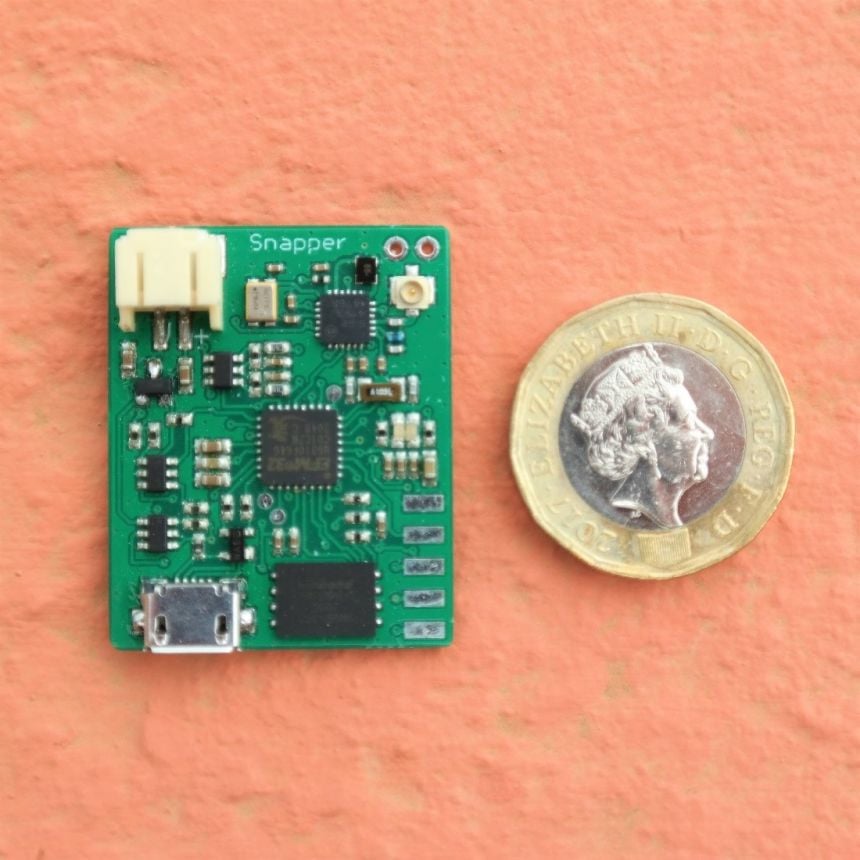 A SnapperGPS board next to a £1 coin. It measures only 3.5 cm x 2.8 cm.
A SnapperGPS board next to a £1 coin. It measures only 3.5 cm x 2.8 cm.Image credit: SnapperGPS team
In summer 2021 SnapperGPS was deployed on nesting loggerhead sea turtles (Caretta caretta) on the island of Maio in Cape Verde.
Loggerhead sea turtles spend most of their life in the ocean, but every two to three years mature females come to a beach to nest. They lay several clutches of eggs separated by roughly two weeks, which makes it possible to recover the hardware and any data it captured.
Navigation satellite signals cannot travel through water, but sea turtles regularly come to the surface to breathe. These short windows of opportunity may not always be enough for traditional GPS methods to resolve the position of the receiver. But a snapshot method only requires milliseconds of the signal which makes them ideal for such marine applications.
For this turtle deployment, the SnapperGPS tags were placed into custom-made enclosures that were tested to be waterproof to at least 100 m.
Due to the COVID-19 pandemic, they had to deploy the tags late in the nesting season which negatively affected our recovery rate as many turtles were already laying their last nest when they were tagged.
In total twenty tags were deployed and nine recovered. Some experienced unexpected technical failures but the tags that survived were able to capture several location tracks that showed unexpectedly diverse behaviour among turtles.
Wildlife location tracking data can inform conservation policy decisions that help protect habitats and prevent human-wildlife conflicts.
This data provides novel insights into the loggerhead sea turtle population on Maio. The exercise also taught the team important lessons about the specific challenges of deploying SnapperGPS on a sea turtle and they are working on an improved version for next year’s nesting season.
Wildlife location tracking data can inform conservation policy decisions that help protect habitats and prevent human-wildlife conflicts. In the case of loggerhead sea turtles, understanding their movements can inform where to direct anti-poaching measures and it can identify important marine habitats that may need special protection.
SnapperGPS is supported by an EPSRC IAA Technology Fund. Additionally, Amanda and Jonas receive support from the EPSRC Centre for Doctoral Training in Autonomous Intelligent Machines and Systems (AIMS CDT). The field work was made possible through a cooperation with the Maio Biodiversity Foundation and the Arribada Initiative.
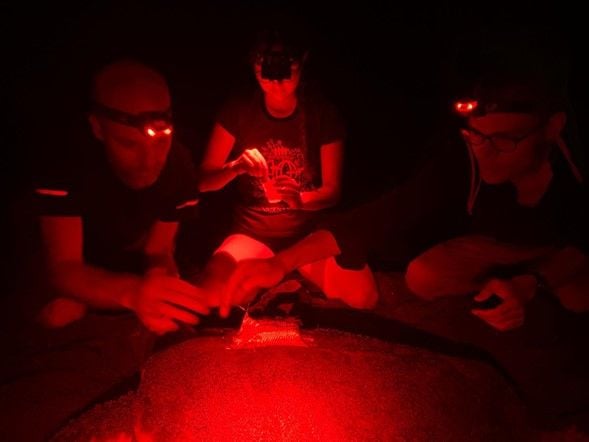 SnapperGPS team has tracked to a location of a loggerhead sea turtle captured by a SnapperGPS tag.
SnapperGPS team has tracked to a location of a loggerhead sea turtle captured by a SnapperGPS tag. Image credit: SnapperGPS team
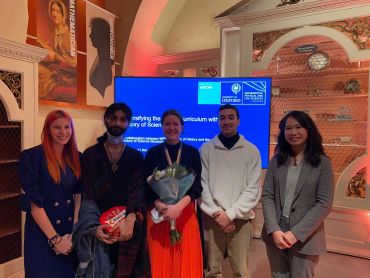 The four of the five undergraduate students from different universities who participating in the internship across five STEM-based subjects.
The four of the five undergraduate students from different universities who participating in the internship across five STEM-based subjects. The Diversifying STEM Curriculum project has created a unique and original collection of online materials engaging with some significant issues currently discussed in higher education and wider society.
The material reflects upon key scientific concepts and research and places them into wider historical contexts than has been the norm. In particular it highlights diverse contributions that have previously not been given the recognition they deserve including: ethnicity, gender, nationality, sexual orientation, disability, class and religion.
Each research project explores specific issues within their subject curricula to broaden the global historical and social context to scientific research
Jo Knights from Equality, Diversity and Inclusion team at the Mathematical, Physical and Life Sciences (MPLS) Division, said: ‘Each research project explores specific issues within their subject curricula to broaden the global historical and social context to scientific research, to give agency to scientists who have not been appropriately recognised, and to provide lecturers, researchers, students – anyone who is interested in diversifying their curricula – the content and research to integrate these projects into their teaching and learning.’
The projects aim to support the cultural shift towards a STEM curriculum that embraces an interconnected global view of sciences and maths, one that includes a diverse range of people and a more inclusive historical context.
The inaugural Diversifying STEM Curriculum project began in the summer of 2021, with five undergraduate students from different universities participating in a two-month internship across five STEM-based subjects at the University of Oxford. The students picked their own research topics and developed their final projects in collaboration with each other and their supervisors. The projects include:
Aleisha - Biology
By focusing on science as a process, I want to demonstrate how information builds and develops, and how it is communicated across cultures. I especially wanted to highlight the importance of agency, as oftentimes the narratives I’d heard would give agency to European scientists, but less so to people from other communities. I’ve chosen to discuss the world’s most consumed psychoactive drug: caffeine. Specifically, this project centres around coffee and yerba mate: two plants with seemingly opposing stories.
Mathematical history has brought out narratives about science that often focus on the singular, brilliant scientist, in most cases male and European,.... despite the ways in which the historical narrative is presented to the public, the evolution of mathematics is hardly as straightforward and linear as it may seem to be.
Adil - Physics:
My project seeks to provide a decolonialist account of South Asian science by interrogating the scientific-historical environment of colonial India at the time of its acceptance into western scientific spheres in the mid-20th century.’
Samy - Mathematics:
‘Teaching of mathematical history has brought out narratives about science that often focus on the singular, brilliant scientist, in most cases male and European, who makes substantial contributions through their innate genius. However, despite the ways in which the historical narrative is presented to the public, the evolution of mathematics is hardly as straightforward and linear as it may seem to be. We must therefore begin our delving into this history of mathematics as an attempt to unveil our own cultural prejudices.’
Sara - Chemistry
‘Named reactions are a very useful tool in organic chemistry and their importance became evident as their number increased through time. However, they are becoming increasingly controversial. One of the major issue arising is that at least half of the population was blatantly forgotten in the naming process: women. I am highlighting the origins behind the limited number of reactions named after women in the first thirty years of the 20th century and celebrating the achievement of women pioneers in organic chemistry in Europe.’
One of the major issue arising is that at least half of the population was blatantly forgotten in the naming process: women.
Yayan - Engineering:
Engineering has developed rapidly in the UK and has been one of the main engines of the UK economy. But it is obvious that the gender imbalance in engineering is relatively high, compared with other industries. In 2016, women only accounted for 21% of the engineering workforce, comparing with 47% in all industries on average. I’m investigating how gender equality was improved in the past, and if there are any lessons learnt which can improve gender equality at the present. I’m looking particularly at the inter-war years because women engineers started to realise the importance of gender equality and took various approaches to promote women’s status in engineering.’
The Departments of Chemistry, Engineering Science, Maths, Physics and Zoology have partnered with the Faculty of History and the History of Science Museum for these projects. Funding has been received from the Vice Chancellor's Diversity Fund.
See all the projects here: https://www.mpls.ox.ac.uk/equality-and-diversity/diversifying-stem-curriculum-projects-2021
Cutting-edge scientific study of gold coins from different moments of the Roman Empire has revealed a thriving economy in the periods when the coins were minted.
Researchers from the University of Oxford and the University of Warwick brought three Roman coins for analysis by the Science and Technology Facilities Council’s ISIS Neutron and Muon Source. Each coin was from the reign of a different Roman emperor: one from Hadrian (2nd century AD), one from Tiberius (early 1st century AD) and one from Julian II (4th century AD).
When high-value artefacts need to be analysed, researchers are generally required to employ non-destructive techniques. The aim in this case was to see if the coins had been surface enriched – or secretly mixed with other metals. By doing this, the team could deduce a number of things, including the levels of economic stability.
The results from the surface level analyses of these coins suggested that they were very high purity gold...We know the Romans deliberately surfaced enriched their silver coins to ‘hide’ the fact there was a lot of copper in them, so it is plausible something similar happened to the gold
Dr George Green
Lead author, Dr George Green, Leverhulme Trust Early Career Fellow and Lavery-Shuffrey Early Career Fellow in Roman Art and Archaeology at the University of Oxford, says, ‘The results from the surface level analyses of these coins suggested that they were very high purity gold. However, these measurements were from the first few fractions of millimetres of the coins. There was a very reasonable ‘what if’ of ‘what if they’re actually made of something different beneath the surface?’ We know that the Romans deliberately surfaced enriched their silver coins to ‘hide’ the fact there was a lot of copper in them, so it is plausible something similar happened to the gold.
‘Our work at ISIS enabled us to sample the very centre of these coins totally non-destructively and conclusively show that the high purity seen on the surface was representative of the composition of the ‘core’ of the coin. At a basic level, it is further testament to the economic health of the Roman Empire, but these conclusions are also useful for researchers who need to employ non- or negligibly-destructive techniques on the surfaces of Roman gold coins. Now they can be confident the surface is representative of the bulk of these objects.’
Our work at ISIS...conclusively shows the high purity on the surface was representative of the ‘core’
To measure the purity of the gold coins they used muonic X-ray emission spectroscopy, a totally non-destructive analytical process that involves firing negative muons at the artefact. The muons are then captured by the atoms within the coins, which then emit a ‘fingerprint’ of muonic X-rays that are unique to the chemical element they came from.
Using this technique allows scientists to probe deeper into the elemental make-up of the historical artefacts than possible with other methods, while being entirely non-destructive.
Muonic X-ray emission spectroscopy also does not require the object to be cleaned before analysis, reducing the workload placed on cultural heritage institutions. Cleaning some artefacts can actually lead them to become damaged, so this technique is particularly useful for analysing objects still covered in a layer of mud or soil – such as those salvaged from shipwrecks.
These results highlight the potential of this technique within the field of cultural heritage. It is a non-destructive technique...making it a perfect tool for those working on museum collections
Dr Adrian Hillier
Dr Adrian Hillier, lead instrument scientist at ISIS and the muon group leader, says, ‘These results highlight the potential of this technique within the field of cultural heritage. It is a non-destructive technique that can sample deep beneath the surface of archaeological objects. It requires no sample preparation and does not leave the artefact radioactive, making it a perfect tool for those working on museum collections.
‘Beyond working out the sub-surface purity of an object it could: determine the depth of any corrosion on an object; identify chemical changes within the artefact caused by unique manufacturing processes; or reveal that an object we thought was made of one thing is actually a forgery made of another – all without causing any damage.’
The RIKEN-RAL muon beamlines at the ISIS Neutron and Muon source was used as they could produce muons with a high enough momentum to penetrate deep beneath the surface of the artefact being studied. The muons are created by bombarding a carbon target with high energy protons, this causes the creation of pions which are extracted and then decay into muons. These muons have a range of different momenta; the muons with lower momentum are used to analyse the surface of the artefact and the high momentum muons pass deeper into the artefact obtaining data from its core.
See the journal article.
- ‹ previous
- 10 of 247
- next ›
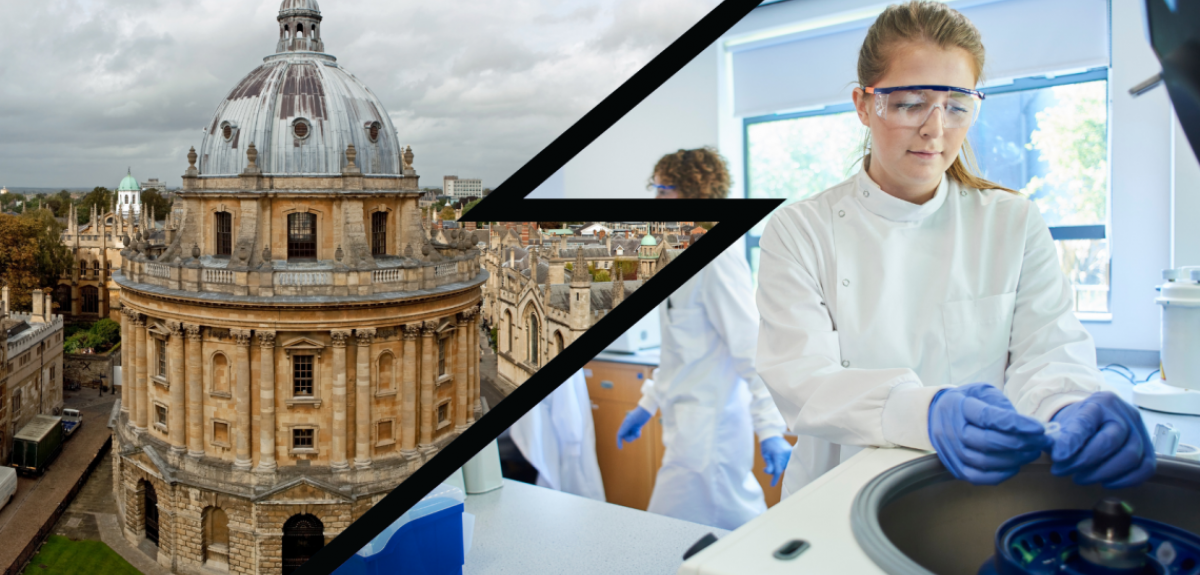

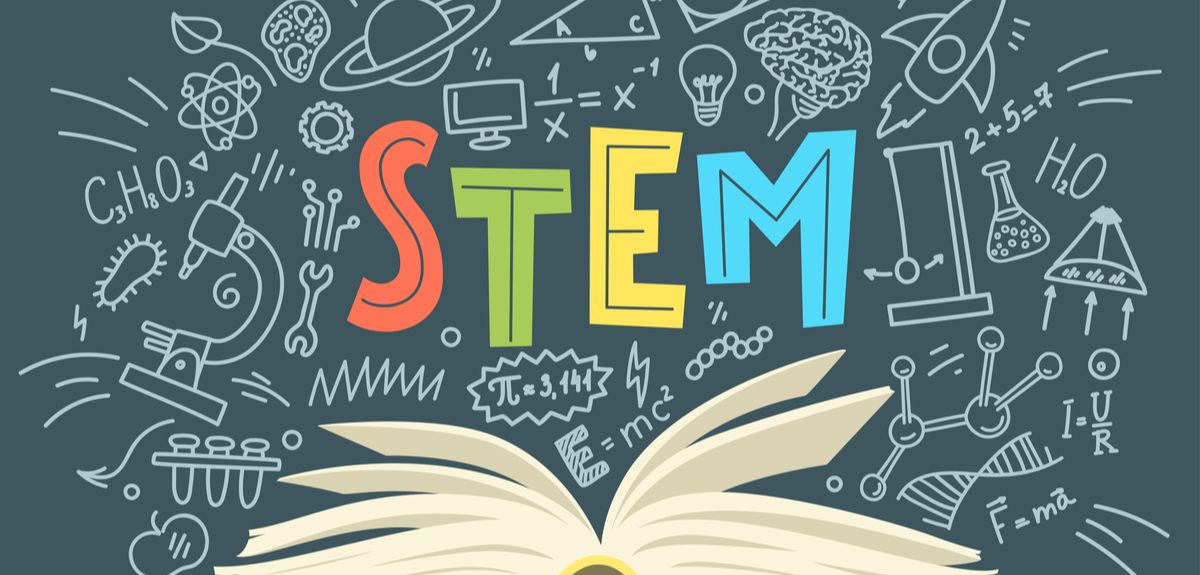

 From research to action: How the Young Lives project is helping to protect girls from child marriage
From research to action: How the Young Lives project is helping to protect girls from child marriage  Can we truly align AI with human values? - Q&A with Brian Christian
Can we truly align AI with human values? - Q&A with Brian Christian  Entering the quantum era
Entering the quantum era Can AI be a force for inclusion?
Can AI be a force for inclusion? AI, automation in the home and its impact on women
AI, automation in the home and its impact on women Inside an Oxford tutorial at the Museum of Natural History
Inside an Oxford tutorial at the Museum of Natural History  Oxford spinout Brainomix is revolutionising stroke care through AI
Oxford spinout Brainomix is revolutionising stroke care through AI Oxford’s first Astrophoria Foundation Year students share their experiences
Oxford’s first Astrophoria Foundation Year students share their experiences DPhil student, Frankco Harris, reflects on his unique journey to Oxford and future plans
DPhil student, Frankco Harris, reflects on his unique journey to Oxford and future plans Oxford undergraduates reflect on their first term
Oxford undergraduates reflect on their first term